1993 BUICK ROADMASTER light
[x] Cancel search: lightPage 161 of 340
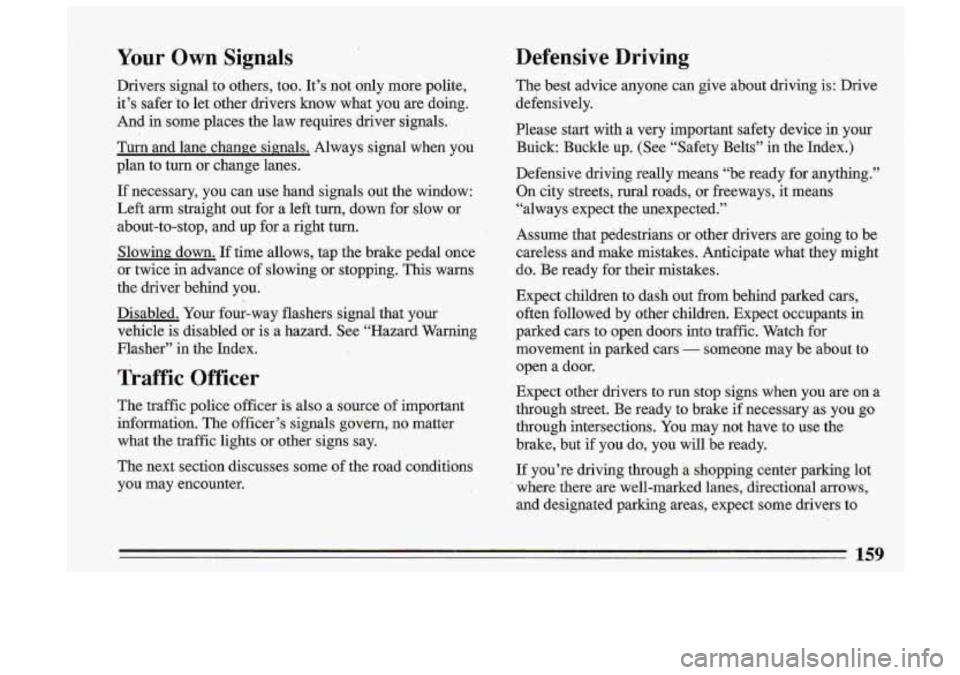
Your Own Signals Defensive Driving
Drivers signal
to others, too. It’s not only more polite,
it’s safer ‘to let other drivers know what you are doing.
And in some places the law requires driver signals.
Turn and lane change signals. Always signal when you
plan to turn or change lanes.
If necessary, you can
use hand signals out the window:
Left arm straight out for
a left turn, down- for slow or
about-to-stop, and up for a right turn.
Slowing. down. If time allows, tap the brake pedal once
or twice
in advance of slowing or stopping. This warns
the driver behind you.
Disabled. Your -four-way flashers signal that your
vehicle is disabled or is a hazard. See “Hazard Warning
Flasher” in the Index.
Traffic Officer
The traffic police officer is also a source of important
information.
The officer’s signals govern, no matter
what the traffic lights or other signs say.
The next section discusses some of the road conditions
you
may encounter. The
best advice anyone can give about driving is: Drive
i
defensively. !
Please start with a very important safety device in your
Buick: Buckle up. (See “Safety Belts” in the Index.) i
Defensive driving really means “be ready for anything.”
On city streets, rural roads, or freeways, it means
“always expect the unexpected.”
Assume that pedestrians or other drivers are going to be
careless and make mistakes. Anticipate what they might
do. Be ready for their mistakes.
Expect children to dash out from behind parked cas,
often-followed by other children. Expect occupants
in
parked cars to open doors into traffic., Watch for
movement
in parked cars - someone may be about to
open a door.
Expect other drivers to run stop signs when. you are on a
through street. Be ready to brake if necessary
as you go
through intersections. You may not have
to use the
brake, but if you do, you will be ready.
If you’re driving through a shopping center parking lot
where there are well-marked lanes, directional arrows,
and designated parking areas, expect.some drivers to
159
__
Page 164 of 340
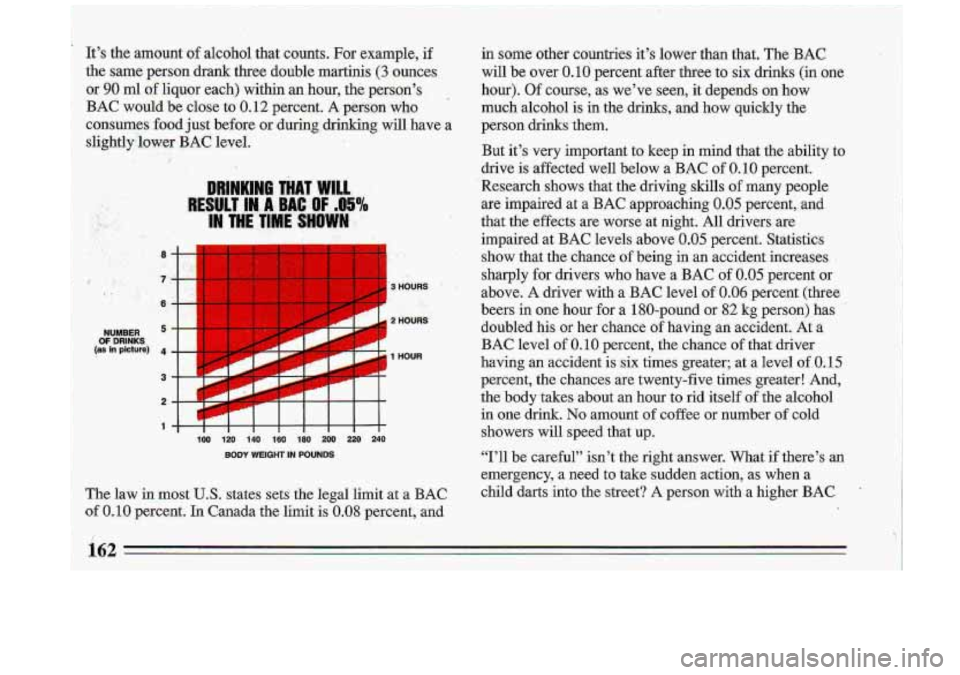
It’s the arnount.of alcahd that counts. For example, if
the same person drank three double martinis,
(3 ounces
or
90 ml of liquor each) within an hour, the persqn’s,
BAC would be close to 0.12 percent. A person who
consumes fwd
just before or during drinking will. have a
slightlyi’lower
BA@ -, level’.
..
..
DRINKING THAT WILL
, .,11 RESULT IN, A BAC -OF .@5’/0
.. IN THE JiME. SHOWN. .. .. ., C‘ , . ’/ ,.
p; ,~ I, ..I.’ ., . x-j:.
,? . 3 HOURS ’, ’ , 1, : (.
(as in picture) 4 OF DRI-NKS
T 2 7111
2 HOURS
1 HOUR
in some other countries it’s lower than that. The BAC
will be over 0.16 percent after three to six drinks (in one
hour).
Of course, as we’ve seen, it depends on how
much alcohol is in the drinks, and how quickly the
person drinks them.
But it’s very important to keep in mind that the ability to
drive is affected well below a
BAC of 0.10 percent..
Research
shows that the driving skills of many people
are impaired at
a BAC approaching 0.05 percent, and
that the effects are worse at night. All drivers are
impaired at
BAC levels above 0.05 percent. Statistics
show that the.chance
of being in an accident increases
sharply for drivers who have a
BAC of 0.05 percent or
above. A driver with a BAC level of 0.06 percent (three
beers
in one hour for a 180-pound or 82 kg person) has
doubled his or her chance
of having an accident. At a
BAC level of 0.10 percent, the chance of that driver
having an accident
is six times greater; at a level of.O.15
percent, the chances are twenty-five times greater! And,
the body takes about an hour
to rid itself of the alcohol
in one drink.
No amount of coffee or number of cold
showers will speed that up.
“I’ll be careful’’
isn’t the right,answer. What if there’s an
emergency, a need.
to take sudden action, as when a
child darts into the street? A person with a higher BAC
1 1
1:O IiO 1:O 1:O 16B 2:O 2:O 240 I
BODY WEIGHT’IN POUNDS
Page 166 of 340
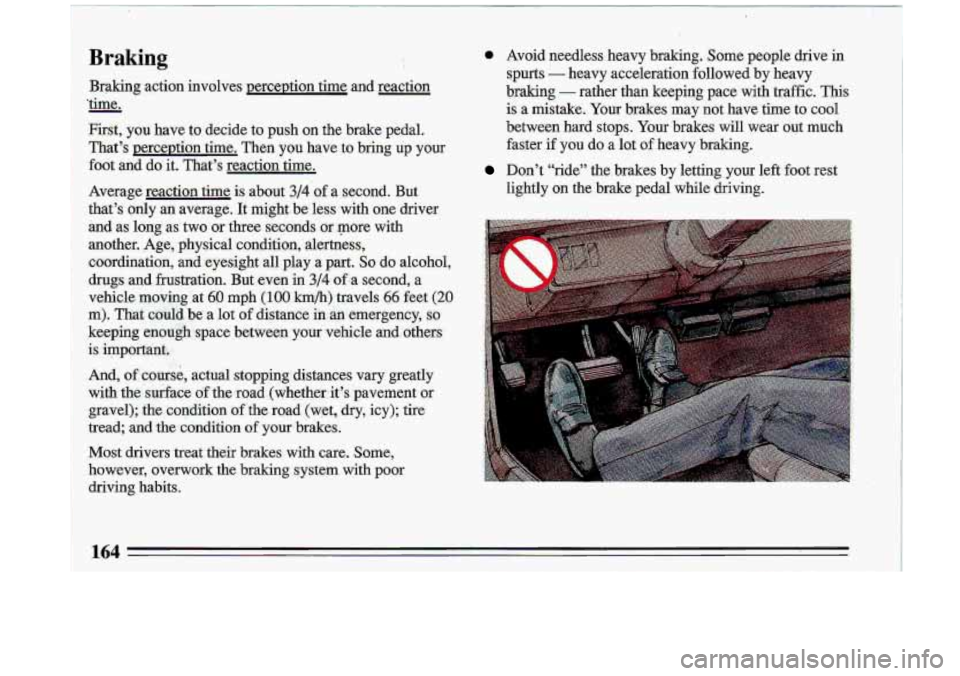
Braking
Braking action- involves perceDtion time and reaction
’time.
First, you have to decide to push on the brake pedal.
That’s perception time. Then -you have to bring
up your
foot and do it. That’s reaction-time.
-
Average reaction time is about 314 ‘of a second. But
that’s only -an average. It might be less with one driver
and as
long as two or.three seconds or .more with
another.
drugs and frustration. .But even in
3/4 0f.a second, a
vehicle moving at
60 mph (1 00 h/h) travels 66 feet: (20
m). That could. be a lot of distance in an-emergency, so
keeping enough- space between your vehicle and-others
is important.
And, of course, actual stopping distances vary greatly
with the saiface- of the raad.(whether it’s pavement or
gavel); the condition of the road (wFt, dry, icy); tire
tread; and
the condition of your brakes.
Most -drivers treat their brakes with care. Some,
however; overwork the braking system with poor
driving habits.
* Avoid needless heavy braking. Some people drive in spurts
- heavy acceleration followed by heavy
braking
- rather than keeping pace with traffic. This
is a mistake. Your brakes may not have time to cool
between hard stops. Your brakes will wear out much faster if you do a lat of heavy braking.
Don’t “ride” the brakes by letting your left foot rest
lightly on the brake pedal while driving.
Page 170 of 340
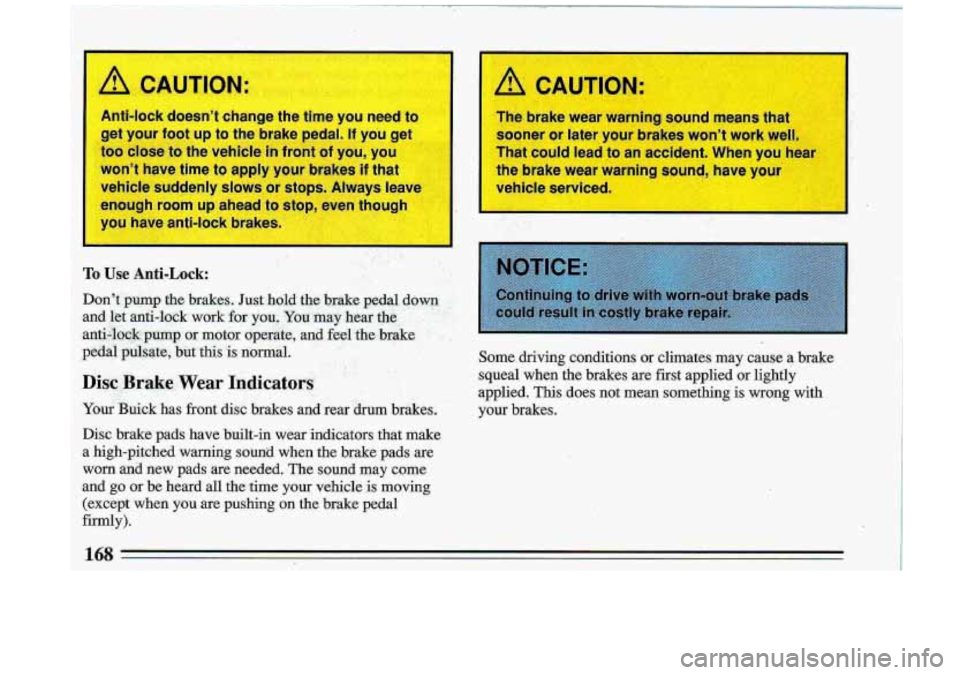
I
1 /! CAUTION: A CAUTION:
The brake wear warn g s
sooner or later your brakes won’t work well
That could lead
to an accident. When you hear
the brake wear warning
-- -3 your
vehicle serviced. -. --I - ,~
I
Some driving conditions or climates may cause a brake
squeal when the brakes are first applied or lightly
applied. This
does not mean something is wrong with
your brakes.
Page 172 of 340
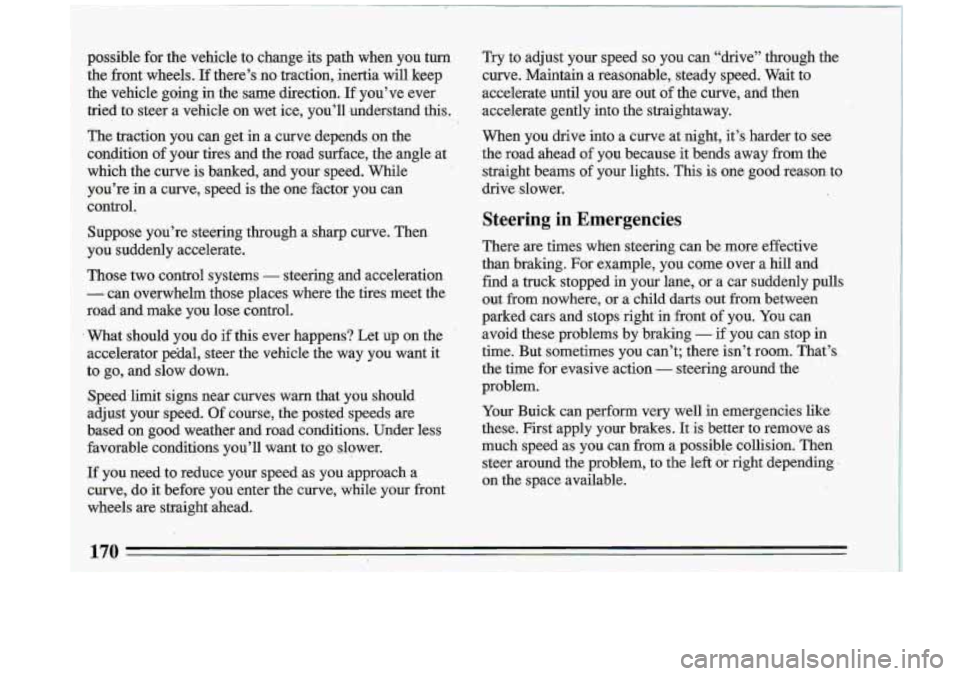
Try to adjust‘ your speed so you can “drive” through the
curve. Maintain a reasonable, steady speed. Wait to
accelerate until you are out
of the curve, and then
accelerate gently
into the straightaway.
When you drive into a curve at night, it’s harder to see
the road ahead
of you because it bends away from the
straight beams
of your lights. This is one good reason. to
drive slower.
Steering in Emergencies
There are times when steering can be more effective
than braking. For example, you come over a hill and
find a truck stopped
in your lane, or a car suddenly pulls
out
f-rom nowhere, or a child darts out from between
parked
cars and stops right in front of you. You can
avoid these problems by braking
- if you can stop in
time. But sometimes you can’t; there isn’t room. That’s\
the time for evasive action
- steering around the
problem.
Your Buick can perform very well in emergencies like
these. First apply your brakes. It is better to remove as
much speed as you can
from a possible collision. Then
steer around the problem, to the left
or right depending
on the space available,
Page 177 of 340

vehicle is skidding. Learn to recognize warning clues -
such as enough water, ice or packed snow on the road to
make a “mirrored surface’’
- and slow .down when you
.have any doubt.
Remember: Any anti-lock braking system (ABS) helps
avoid only the braking skid. Steer the way you want
to
go-
Driving at Night
Night driving is more dangerous than day driving. One
reason is that some drivers are likely to be impaired
-
by alcohol or drugs, with night vision prob1ems;or by
fatigue.
Here are some tips on night driving.
0
0
0
0
a
0
0
Drive defensively. Remember, this is the most
dangerous time.
Don’t drink and drive. (See “Drunken Driving.” in
the Index for more on this problem.)
Adjust your inside rearview mirror to reduce the
glare from headlights behind you.
Since’ you can’t see as well,
you may need to slow
down and
keep more space between you and other
vehicles. It’s hard to tell how fast the vehicle ahead
is going just
by looking at its taillights,
Slow down, especially on higher speed roads. Your
headlights can light up only
so much road ahead.
In remote areas, watch for animals.
If you’re tired, pull
off the road in a safe place and
rest.
175
I
.!
I
Page 178 of 340
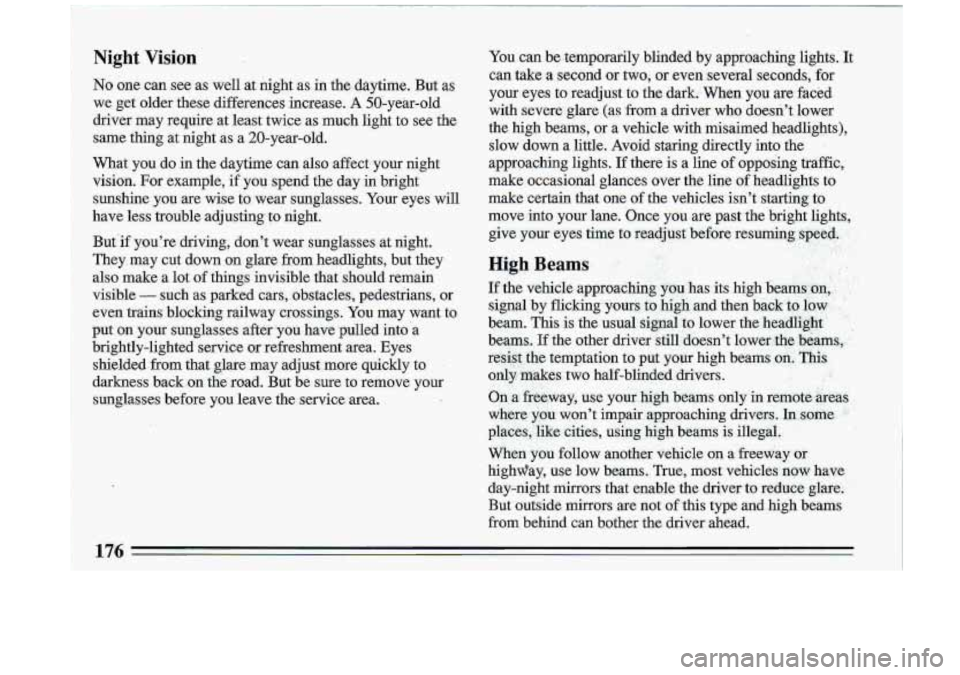
Night Vision
'No one can see as we11 at night as in the daytime. But as
we get older these differences increase.
A 50-year-old
driver may require .at least twice as much light
to see the
same thing at night as a 20-year-old.
What you do in the daytime can also affect your night
vision.
For example, if you spend the day in bright
sunshine you are wise to wear sunglasses.
Your eyes will
have less trouble adjusting to night.
But'if you're driving, don't wear sunglasses at night.
They.may cut down on glare from headlights, but they
also make a lot
of things invisible that should remain
yisible
- such as parked cars, obstacles, pedestrians, or
even train5 blocking railway crossings. You mzy want to
put on
your sunglasses -after ,you have pulled into a
brightly-lighted service or refreshment area. Eyes shie1ded.from that glare
may adjust.more quickly to
darkne,ss back on the road. But be sure to remove your
sunglasses before
you leave the service area.
When you .follow another vehicle
on a freeway or
highday, use low beams. True, most vehic1e.s now.have,
day-night mirrors that enable the driver to reduce glare.
But outside mirrors are not
of this type and.high beams
from behind can bother the driver ahead.
176
Page 182 of 340
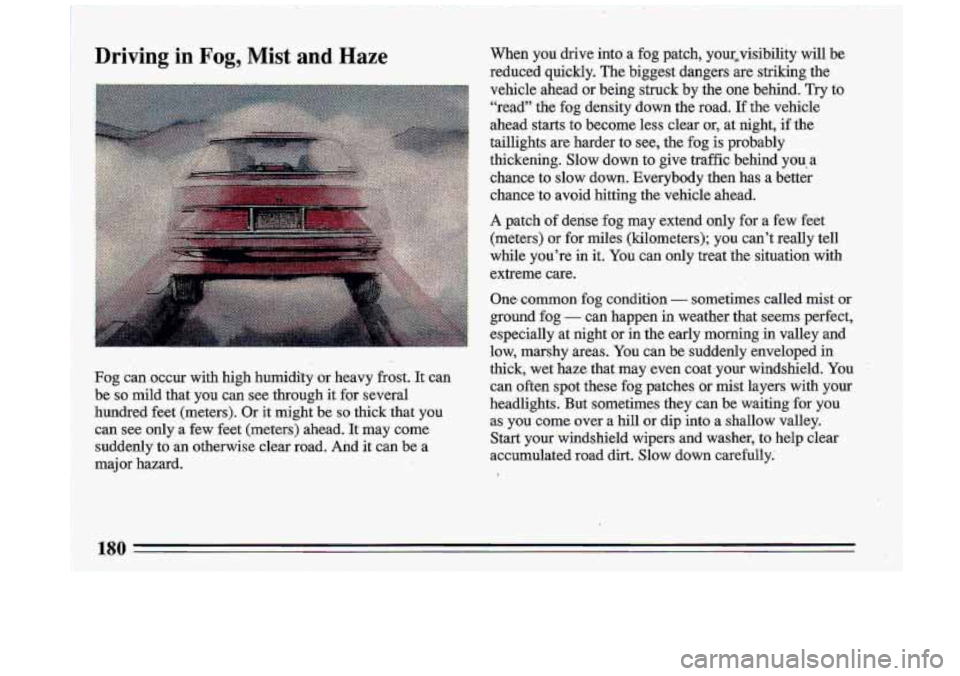
Driving in Fog, Mist and Haze When you drive into a fog patch, your$sibility will be
reduced quickly. The biggest dangers
are striking the
vehicle ahead or being struck by the
one behind. Try to
‘‘read” the fog density down the road.
If the vehicle
ahead starts to become less clear
or, at night; if the
taillights are harder to see,
-the fog is probably
thickening. Slow down to give- traffic behind you. a
chance to slow down. Everybody then has a better chance.to avoid hitting the vehicle ahead.
A patch of derise fog may extend only for a few feet
(meters) or for miles (kilometers); you can’t really tell
while you’re
in it. You can only treat ‘the situation with
extreme tare.
One, common fog condition - sometimes called mist or
ground fog - can happen in weather that seems perfect,
especially at night or in the early
morning in valley and
low, marshy areas. You can be suddenly enveloped
in
thick, wet haze that may even coat ,your windshield. You
can often spot these fog patches .or mist layers with
your
headlights. But sometimes they can be waiting for you
as you come over a hill or dip into a. shallow valley.
Start your windshield wipers and washer, to help clear
accumulated road dirt. Slow down carefully.’
Fog can occur with high humidity or heavy frost. It can
be
so mild that- you can see through it for several
hundred feet (meters). Or-it might
he so thick .that you
can see only
a few feet (meters) ahead. It may come
suddenly
to an otherwise clear road. And it can be a
major hazard.